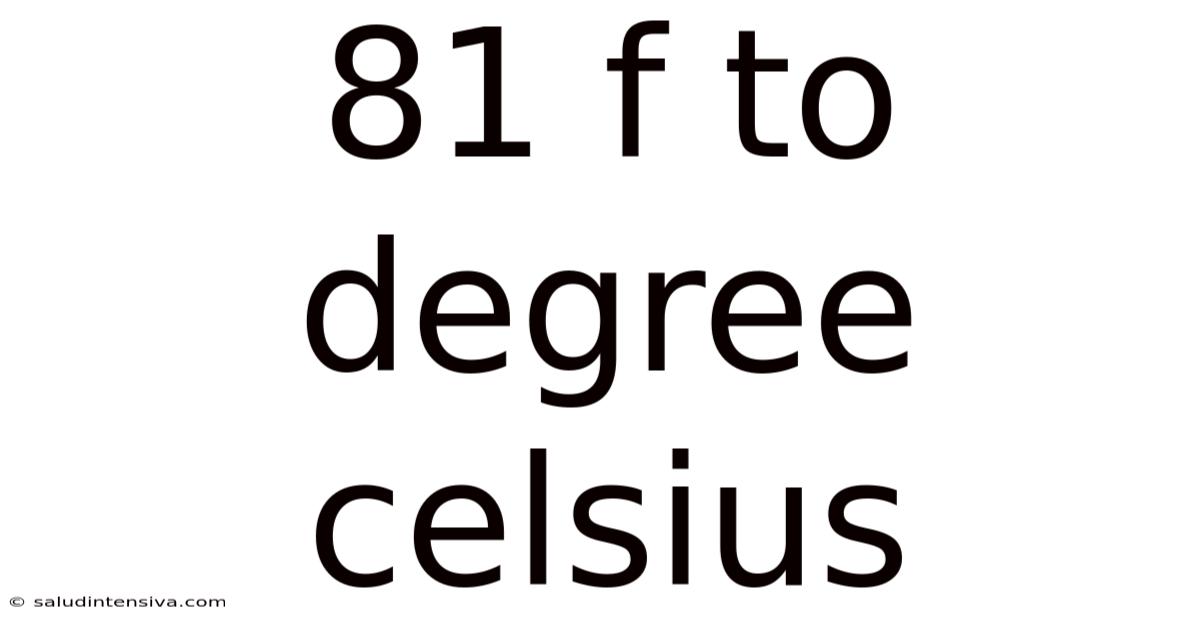81 F To Degree Celsius
saludintensiva
Sep 15, 2025 · 5 min read

Table of Contents
Converting 81°F to Celsius: A Deep Dive into Temperature Conversion
Understanding temperature conversion is crucial in various fields, from cooking and everyday life to scientific research and engineering. This article will comprehensively guide you through the process of converting 81 degrees Fahrenheit (°F) to degrees Celsius (°C), explaining the underlying formula, providing step-by-step instructions, and exploring the practical applications of this conversion. We'll delve into the history of temperature scales and even touch upon some common misconceptions. By the end, you'll not only know the Celsius equivalent of 81°F but also possess a solid understanding of temperature conversion principles.
Understanding Fahrenheit and Celsius
Before diving into the conversion, let's briefly review the two temperature scales: Fahrenheit and Celsius.
-
Fahrenheit (°F): This scale, developed by Daniel Gabriel Fahrenheit in the early 18th century, uses the freezing point of water as 32°F and the boiling point as 212°F, at standard atmospheric pressure.
-
Celsius (°C): Also known as the centigrade scale, Celsius uses the freezing point of water as 0°C and the boiling point as 100°C, again at standard atmospheric pressure. This scale is now the most widely used temperature scale globally, favored for its simplicity and logical structure.
The difference in the scales lies in the choice of reference points and the size of the degree intervals. This difference necessitates a conversion formula when moving between the two scales.
The Conversion Formula: From Fahrenheit to Celsius
The formula to convert Fahrenheit (°F) to Celsius (°C) is:
°C = (°F - 32) × 5/9
This formula takes the Fahrenheit temperature, subtracts 32 (to adjust for the difference in the freezing point), and then multiplies the result by 5/9 (to account for the different degree intervals).
Step-by-Step Conversion of 81°F to Celsius
Let's apply the formula to convert 81°F to Celsius:
Step 1: Subtract 32 from the Fahrenheit temperature:
81°F - 32 = 49
Step 2: Multiply the result by 5/9:
49 × 5/9 = 27.222...
Step 3: Round the result (if necessary):
Rounding to one decimal place, we get 27.2°C.
Therefore, 81°F is equal to approximately 27.2°C.
Why the 5/9 Factor?
The 5/9 factor in the conversion formula arises from the difference in the size of the degree intervals between the Fahrenheit and Celsius scales. The 180-degree difference between the boiling and freezing points of water in Fahrenheit (212°F - 32°F = 180°F) corresponds to a 100-degree difference in Celsius (100°C - 0°C = 100°C). The ratio of these differences is 180/100, which simplifies to 9/5. Since we're converting from Fahrenheit to Celsius, we use the reciprocal, 5/9.
Practical Applications of Temperature Conversion
The ability to convert between Fahrenheit and Celsius is essential in numerous contexts:
-
International Communication: Many countries use Celsius, while others use Fahrenheit. Accurate conversion is crucial for clear communication in international collaborations, scientific research, and global commerce.
-
Cooking and Baking: Recipes often specify temperatures in either Fahrenheit or Celsius. Conversion ensures you achieve the correct cooking temperature regardless of the recipe's origin.
-
Medicine and Healthcare: Body temperature is measured in both scales, and accurate conversion is essential for accurate diagnosis and treatment.
-
Meteorology: Weather reports often provide temperatures in both scales, enabling a broader understanding across different regions.
-
Engineering and Manufacturing: Many industrial processes require precise temperature control, and accurate conversion is critical for ensuring the quality and safety of manufactured products.
-
Scientific Research: Accurate temperature measurement and conversion are fundamental in various scientific fields, including chemistry, physics, and materials science.
Common Misconceptions about Temperature Conversion
A common mistake is to simply add or subtract a fixed number to convert between Fahrenheit and Celsius. This is incorrect because the scales are not linearly related; their relationship is defined by the conversion formula. Remembering and correctly applying the formula is crucial for accurate conversion.
Frequently Asked Questions (FAQ)
Q1: Is there a formula to convert Celsius to Fahrenheit?
Yes, the reverse conversion formula is: °F = (°C × 9/5) + 32
Q2: Why are there different temperature scales?
Different scales emerged historically, with Fahrenheit being one of the earliest widely used scales. Celsius gained popularity due to its simpler structure and logical referencing points based on the properties of water.
Q3: Are there other temperature scales besides Fahrenheit and Celsius?
Yes, there are other scales, such as Kelvin (K), which is the absolute temperature scale used in scientific applications. Kelvin starts at absolute zero, the theoretical lowest temperature possible.
Q4: How accurate does the conversion need to be?
The required accuracy depends on the application. In some cases, rounding to the nearest degree is sufficient, while others demand higher precision. Always consider the context and the level of precision needed for the task.
Conclusion
Converting 81°F to Celsius, which results in approximately 27.2°C, is a straightforward process using the formula (°F - 32) × 5/9. Understanding this conversion is essential for various applications across different fields. This article has provided a comprehensive guide, explaining not only the mechanics of conversion but also the underlying principles and practical implications. Remember that accurate temperature conversion is crucial for communication, scientific accuracy, and safe operation in numerous contexts. Mastering this skill enhances your understanding of the physical world and your ability to effectively navigate various situations requiring precise temperature measurement and conversion.
Latest Posts
Latest Posts
-
Surface Area Of Cuboid Calculator
Sep 15, 2025
-
4 000 Divided By 8
Sep 15, 2025
-
Gcf Of 28 And 35
Sep 15, 2025
-
2 3 As Mixed Number
Sep 15, 2025
-
8 Out Of 11 Percentage
Sep 15, 2025
Related Post
Thank you for visiting our website which covers about 81 F To Degree Celsius . We hope the information provided has been useful to you. Feel free to contact us if you have any questions or need further assistance. See you next time and don't miss to bookmark.